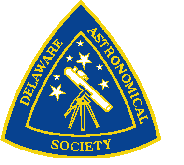

|
Don Shedrick |
Mar 6, 2002 |
March DAS Focus
COMPUTERS IN ASTRONOMY by Don Shedrick
To celebrate the February meeting subject with the terrific Junior Member presentations, and the upcoming April 20 Astronomy Day, we are this month featuring a web site dedicated to youth in astronomy.
The Youth Activities Committee web site at:
http://www.youthinastronomy.org/index.html
is maintained by Ryan Hannahoe for the Astronomical League. It is formed to bring youth into astronomy and to increase knowledge among young people.
Among the various links on this site is the Virtual Telescope Program (VTP) at:
http://www.youthinastronomy.org/VTP.html
This program was designed to provide astronomical telescopes for youth to use over the internet through CCD imaging, give youth the chance to see the great wonders of the night sky, and promote astronomy through schools using the VTP. The main goal is to offer youth a chance to see the heavens with large telescopes, and to open up a New World of astronomy for them. They have an impressive list of observatories and large telescopes signed up to help with this program.
Once you sign up and register, a proposal is sent to the Chairman, and if approved, to one of the participating observatories where the CCD imaging of the selected celestial object is obtained. The image is processed into a JPG or GIF file and in 1 - 2 weeks emailed back to the person who submitted the proposal.
Another link is for the Youth in Astronomy Chat sponsored by ICSTARS.com. They offer a Chat with an astronomer every third Thursday of every month. The web site is at:
A link is provided to the Astronomical League Observing Programs Youth Resources at:
http://www.observetheheavens.homestead.com/
The Astronomical League Youth Activities Committee's Observing Awards Coordinator encourages fellow youth to engage in the 16 Astronomical League "Observe" programs, providing links for articles on the A.L. observing programs, images of the certificates and pins awarded, and links of interest on the clubs. From this site, a link takes you to the Observing Tips and Strategies site at:
http://www.observetheheavens.homestead.com/tipandstrategies.html
where tips and strategies that will maximize your observing time and your equipment are provided. One of the listed tips is for The Universe Sampler observing program at:
http://www.astroleague.org/al/obsclubs/univsamp/univsamp.html
This is a unique A.L. observing program designed specifically for the beginning observer. It is designed to expose the beginner to a sample of the many different types of objects that the Universe has to offer for observing enjoyment. It is designed to help the new observer learn his or her way around the sky and to teach some of the basics of astronomy. It offers an alternate naked-eye list of deep sky objects for those who are interested in astronomy but shy away because they do not have a telescope or binoculars
The Youth Activities Committee web site has a link to the STUDENT TELESCOPE NETWORK homepage at:
http://www.du.edu/~rstencel/stn.htm
The Student Telescope Network (STN) is a collaborative project with the New Mexico Skies, Software Bisque Corp, University of Denver Astronomy Program, and The Youth Activities Committee. Its purpose is to enable high school students interested in astronomical observing to access a telescope with a digital camera in a remote dark location via the Internet, and to pursue basic observational research. The STN uses the Software Bisque Browser Astronomy technology. They have a link to info on this at their web site:
Browser Astronomy gives anyone with access to the Internet using any web browser the ability to remotely control observatories around the world in real time or in an automated (scripted) fashion. No additional software or hardware is required.
Click on the "Ibisque" link to get to their web site page where you can conduct a practice run on the Browser Astronomy Simulator.
http://www.bisque.com/iBISQUE/BrowserAstronomy.asp
From this page, a web-based star chart (powered by TheSky) is your cockpit to the night sky. You can zoom, scroll, and rotate the chart, just like using TheSky from your desktop. Once you've located the object to image, enter its name and then click a button to slew a simulated telescope to that object and have a simulated CCD camera automatically take an image and display it. Experience the future of amateur astronomy from your chair!
The DAS web site has a new link to The Mt. Cuba Astronomical Observatory Clear Sky Clock at:
http://cleardarksky.com/c/MtCubaDEkey.html
This site graphically shows, for Mt. Cuba Astronomical Observatory, Delaware, when it will be cloudy or clear for up to the next two days. It's a prediction of when we will have good weather for astronomical observing. The forecast data comes from the Canadian Meteorological Center. CMC's numerical weather forecasts are unique in that they are specifically designed for astronomers. Check it out!